
This article will appear in the forthcoming Vol. 27 No. 1 / Spring-Summer 2020 issue of West 86th.
My grandfather must have bought me the Junior School Dictionary soon after it was published, because my mother and I left India in 1982. I imagine carting this volume across the oceans, from Madras (it was still called Madras then) to Bethesda, Maryland, the frontispiece emblazoned with my grandfather’s nickname for me, underlined in scarlet ink and stopped with a period. I carry the volume with me still, thirty-eight years later, its fraying spine detaching from the book block, the edges of the pages curled and dirty with use (fig. 1). The illustrations on the cover are eerily prescient; there’s an ancient Greek pot (now a research interest of mine), and a relief from Abydos, Egypt, where I worked for several years on excavation. Did my grandfather foresee this for me? But there’s also a Spanish bull and fighter, and a tiger, none of whom I’ve met in person, so I can’t believe too much in signs. The term “patina” does not appear in this dictionary. Inexplicably, neither does “love.” Or “story.” This slim book of (not enough) old words sits on our bookshelf, dwarfed by a glossy twenty-two-volume set of the 2019 World Book that my children now consult. By comparison, this little book, itself an ancient relic, has little to offer them. And yet they sometimes pull the Junior School Dictionary off the shelf and splay it open. “Careful,” I say, “be careful with it.” My son says it has a good smell. I’ve opened the book and inhaled, but can detect nothing. When I hold it, I feel only the weight of the gift of words, and the promise of the love of words, passed from my grandfather’s hands into mine. Under “conserve,” the entry says, “Conserve (1), n. (usually plural). Preserve, sweetmeat, pastry. (2) v. keep from perishing, decay. Ex. The soldier tried to conserve his energy for climbing the high hill.”1 As a conservator of ancient objects, I find myself in that second guise, almost militaristically bent on saving up the life of things from some impending and yet still-distant hardship. But I had forgotten that first meaning, the preservation of the granular sweetness of something after it has ripened, even rotted. The savoring of something’s concentrated goodness on the tongue and in one’s memory.
Air
There could only be words, no things. Despite all the assurances printed on colorful letterhead and witnessed with florid signatures, I was told that physical access to the ancient and medieval bronzes I had come to Chennai (it was Chennai now, no longer Madras), India, to study was not possible. I had expected to spend months examining ancient bronze surfaces, teasing out stories from the corrosion clinging to the god Siva’s swirling hair as he danced the destruction of the universe. Instead, I was like the demonic creature Siva tramples on in his gleeful, whirling dance, the embodiment of human ego. The Indian gods always win, as does Indian bureaucracy. Sitting dumbstruck in the dusty courtyard in front of the Government Museum, I considered the strangeness of the situation: a conservator who could neither touch nor see objects up close, only view them through an impenetrable barrier of glass. But the archives, I’d been told, were available. I had wanted to say, but this is not how conservators work! We need to look. The stories we tell come from the surface. The stories do not come before—or without—the surface. And yet, there would be only words, no things.
Conservators are expected to have a level of patience that borders on the extreme. Images show us hunched over surfaces, tiny paintbrushes and metal tools in hand, or squinting through microscopes at square millimeters, working for years on the same objects with the aim of making them look like we had never been there in the first place. Our best work is meant to be nearly invisible, and we in turn should recede into the background, forgotten. But what nonconservators do not see is the way that our work is always a negotiation with the surface. We probe objects. We observe so intensely as to learn what questions to ask of things, and to then respond in a way that feels respectful and technically sound. Though this requires patience, it is not inactive, but rather a conversation, a constant shifting of perspective that holds the promise of revelation, if we work deliberately enough. But with papers, one waits. Waiting—for the archivist to arrive, for the right file to be brought, for the perfect incident to have been recorded and thus available—felt more like an act of faith, or perhaps a willingness to simply witness, and hope for a truth to appear.
The museum archives are on the second floor of the building that also houses the current Chemical Conservation Laboratory on the lower level. From the stairs, I could look out on part of the old abandoned conservation laboratory, the one built in 1936 as a monument to the scientific study and conservation of bronzes by Dr. S. Paramasivan,2 the first full-time conservator hired at the museum. I suppose I had really come to Chennai in search of Paramasivan, to learn about the scientist whose work on Indian archaeological material continues to be cited with reverence even today. His publications—in the Proceedings of the Indian Academy of Sciences, Nature, and Current Science—reveal a technical specialist bent on making sense of how the things forged in ancient India might fit recognizable patterns, as though human behavior could be charted into some neat metallographic phase diagram. But for a man whose intellectual imprint was all around me, there was little about Paramasivan the human being. The archives had revealed nothing about his inner life. His former colleague and previous superintendent of the museum, Mr. N. Harinarayana, a man nearly in his nineties when I met him, described Paramasivan as exacting, a fierce defender of the museum, and someone who held his knowledge close. There is one small personal detail, proffered, I imagine, under duress, in a brief essay on the history of the museum laboratory:3 a mugshot-like, blurry photograph of a turbaned Paramasivan, scowling. What was he thinking in that picture? More often than not, I’ve settled on this: “Leave me alone.”
Some mornings, I would await the archivist by sorting through Paramasivan’s old reference books in the conservation laboratory. Some of these precious volumes made their sea journeys from the intellectual centers of Europe and North America mere weeks and months after Paramasivan was hired at the museum in 1930. Whatever excitement or reassurance he might have felt in holding these holy texts in his hands is contained in restrained marginalia. Only small check marks, or the underlining of chemical solutions, or the word “bronze” scribbled on a page foxed with blotches—in one extraordinary instance—traces his presence. I had only ever seen these volumes in the “special collections” sections of libraries in the United States, relics to the care of relics, with little value to the contemporary practice of conserving art, except perhaps as cautionary tales of what should never have been done. Our field is unkind to the pioneering practitioners of the past. In hindsight, we are quick to point out the treatments that went wrong or were too invasive, the ideas that now seem outlandish or without scientific merit. But that is the nature of our training: to be apocalyptic in our assessment of what went wrong, or what will go wrong, with the objects under our care. In Paramasivan’s copy of the Metropolitan Museum’s Restoration of Ancient Bronzes and Other Alloys, he had underlined this phrase: “[preservation work] can be done only by a highly trained expert who like a physician watches and deals instantly with every symptom that develops during his treatment, as otherwise his patient may be lost instead of cured.”4 But our patients are never reunited with loved ones, even the ones that aren’t lost. Our patients never leave our care. We’re always on vigil, waiting.
Documents about conservation work, when they existed in the archives, were often lists of chemicals and equipment and numbers of objects cleaned and coated in preservative. There was no story, no narrative arc, but then again, there’s not meant to be a narrator. Conservators aren’t meant to tell the story. We are expected to intervene and disappear. But disappearing ourselves has consequences for the story of our profession: rarely speaking, rarely writing, means that we are out of the practice of storytelling, and an out-of-practice storyteller forgets that stories are meant for people to hear, to turn over in their memories again and again. The daily practice of sitting with papers about conservation practices was often unassailably dull. I found myself drawn instead to all the other stories of the archive—the thefts, the complaints about inadequate toilets and food service, the dressing down of staff members. I would leave at the end of the afternoon nursing a headache and nausea, physical effects I came to associate with a sense of deflation about my research project, my head bursting with all these other peoples’ stories. It was only later in my tenure at the museum that I was allowed into the back room and I noticed the amber glass bottles of paradichlorobenzene. The insecticide, I learned, had been applied to the archival files for more than half a century, replacing the indigenous use of herbs for pest control. Western scientific institutions had promoted this chemical for the preservation of specimens since the 1920s5 and then stopped using it when its adverse effects on human health became known. But former colonial institutions retained its use, the stories of the past poisoned but preserved.

In the Field Museum’s Restoration of Ancient Bronzes and Cure of Malignant Patina, Paramasivan penciled double lines next to this phrase (fig. 2): “As damage by malignant patina [of bronzes] depends upon three factors—presence of air, moisture, and more or less mobile chlorides—the effective control of any one of them would prevent all damage. Unfortunately most methods of control are impractical.”6 The early twentieth-century conservation literature ascribed either malevolence or nobility to the chemical and physical phenomena that took place on the surfaces of bronzes as they were exposed to air. Surfaces that retained a shiny and even surface were praised for their noble or “edel” patina, but those that dared grow in volume, becoming pustular or powdery, were “malignant.” But “patina” here is simply another word for corrosion, an inescapable negotiation between metal and the atmosphere around it. Why assign it—or the air—a malicious intention? And yet our response as conservators to the malignancy in bronzes is to draw them close, as one might a loved one, to physically engage with the source of their change in state, to bathe or clean their wounds, to apply salves, to make them comfortable again in the air. The interaction of air, object, and conservator produces a new surface. We change things. Things change us.
I almost missed the story when it came. My head had been aching. I felt sick to my stomach. I hadn’t yet discovered the paradichlorobenzene, but it had found its way into me. I forced myself to finish the dull 1942–43 “Administration Report of the Government Museum,” where under the section “Chemical Conservation” was this brief note: “Thanks to the facilities provided by Mr. R. Lean, chief Mechanical engineer and Mr. K. P. S. Nair, Chemist and Metallurgist of the MSM Railway, metallurgical and metallographic investigations on ancient Indian iron and bronze objects were conducted in their laboratories.”7 I took a digital photograph and turned the page, my usual protocol. I skimmed the next page and the next. And then the story came to me in a rush, the way that a story you’ve never heard before seems familiar and inevitable once it has been heard. I turned back the pages. Mr. K. P. S. Nair. A chemist and metallurgist studying ancient bronzes with Paramasivan. A man employed by the Madras and South Mahratta Railways. The giver of Junior School dictionaries. My grandfather.
I called over to the archivist, Mr. Mani. He understood enough of my halting, pathetic Tamil. “Your grandfather, is it?” he said simply, as if people found their relatives in these files all the time. Perhaps they did. He had, after all, been tending the ghosts of the archives for decades. He pointed to the document, the acidic paper cleaving into fragments, and murmured that he should probably sew the pages together. I was fearful that the fracturing paper, milled in wartime, would not survive an intervention. I wanted to shout, “Please, don’t touch this. It’s my grandfather in there!” but instead I shrugged and gently closed the file, placing it on the stack bound for the back room. It wasn’t my place to control what would happen next. Leaving the archives that day, I stopped in front of the abandoned old laboratory, a foreboding padlock on its front door. I imagined my grandfather crossing that threshold to meet Paramasivan, to look at bronzes together. “I’ve come at last,” I wanted to tell them. “Thank you for waiting for me.”
Moisture
The Junior School Dictionary sends seekers of the meaning of “moisture” to consult “damp.” “Slightly wet,” it says, with no sense of how to gauge the slightness of it, something anathema to how conservators work. Our most trusted instruments precisely record “relative humidity,” the moisture the air actually holds in relation to the amount of moisture it might hold at that same temperature and pressure. Conservators call this work “environmental monitoring,” a phrase that belies both the quotidian dullness of tracking these conditions and the gripping panic of what might happen if (when) conditions fall outside our preset parameters. But for all our fear and distrust of humidity, we wish to know how it is, what it is doing, to be in communication with it. Fifty percent relative humidity—drier still for bronzes—we’ve decided, is the ideal condition, but my instruments remind me, usually by text message, how impractical this is: “Warning: Up[per]/Lo[wer] Limit. Unit05. 44% Dec-31. 22:30. End of mail.” How strange and remarkable to be in electronic contact with water droplets. And how ominous that phrase, “end of mail,” as if the humidity itself chooses to break off communication. Paramasivan yearned for such portents, ordering from London in 1937 a “Casella hair hygrograph with daily clock No. 622 and 365 daily charts.”8 That machine relied on bundles of human hair that expanded and contracted with changes in the air. As they plumped or dried out, the hairs moved a disembodied arm fitted with a pen to draw the story of the air on a turning cylinder of graph paper. That same instrument sits in the conservation laboratory (fig. 3), the bundle of hairs perhaps still sipping the inescapable Chennai humidity. But the drawing arm is stopped for good, its last drawing, a sketched history of the conditions of some past, still trapped inside it.
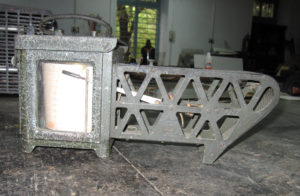
Conservators have a strained relationship with moisture because moisture is mercurial. And as much as we need some moisture to retain the physical integrity of anything living, or once living, too much moisture has the dangerous potential to bring things to life again. Too much moisture, and objects made of plant and animal materials begin to mold. Too much moisture, and iron alloys begin to “weep” orange droplets. Too much moisture, and bronzes erupt in craters of bright green powder known as “bronze disease.” As Paramasivan wrote, “If unchecked, the smallest patch of [malignant patina] will destroy the entire bronze. It is erratic in its action. A patch of it, not larger than a pin’s head, may remain passive for years and then, for no apparent reason, suddenly become active.”9 Moisture waits for its moment, transforming at will from contained and compliant to laden with malevolence, inciting objects to self-destruct. The term “bronze disease” reminds us that earlier practitioners believed that these corrosion products were the result of a communicable biological contagion that spread from object to object.10 I’ve wondered often about how my predecessors imagined the mechanism of transfer, how it passed: through a sharing of air, a sneeze, or the touch of one malignant patch to an edel one? But Paramasivan was well aware that this friable green pox was chemical in nature, evidence of salts inside the bronzes being dissolved and desiccated in cycles through the provocation of the moisture in the air. His most important work was to find a way to passivate these dangerous patches into something more benign, to transform powdery corrosion back into metal again. This work was called electrolytic reduction, a process that ironically required bronzes to become soaking wet, submerged in electrified liquid, untouchable.
Electrolytic reduction offered diseased bronzes a rebirth by baptism in sodium hydroxide.11 They were placed into barrels or “cells”—sized as small, medium, and large—for treatment, something that always reminds me of Goldilocks and the three bears (fig. 4). The few images we have of these treatments show the laboratory emptied of people, as if inviting an archaeological chemist version of Goldilocks to come and turn on the electrical current in the tanks, testing to see which one she liked best. The technique of electrolytic reduction has this fairy-tale quality; malignant bronzes go in, and through the process of being soaked in an electrolyte, they shed their evil and emerge transformed by magic. But as with any good fable, danger lurks. There was no reaching into the electrified cell, of course; touching itself was perilous. And while bronzes went into a clear liquid, as the electrical current worked, the solution became murkier, the bronzes obscured by the green sludge and vigorous bubbling that were part of the treatment process. And despite every preparation, there was the possibility that something might go irreversibly wrong, that “too heavy a current . . . might blast away the corrosive crust, thereby damaging the bronzes.”12 This is the destructive potential of every conservation treatment, and every story: we set forth with a plan, with hope, but also with the awareness that our choices might destroy us, or the things we love the most. But unlike Goldilocks, the stories of electrolytic reduction read more dryly. We only have brief written notes in the “Conservation Register” Paramasivan developed to document the movement of bronzes in and out of his laboratory. The reports of his successor, R. Subramanian, are preserved, their tabular format leaving little space for emotional excess. He writes, “Tuesday 28.10.52. When the electrolysis was started by switching on the Motor-Generator there was an explosion (due perhaps to short circuiting) and it went out of order. It is being repaired and set right by the Electricity Department.”13 There’s a certainty in how he writes about things being “set right.” But there’s no certainty in a real story; that’s what makes it real.
In the only climate-controlled gallery at the Government Museum, I imagined that the Hindu, Buddhist, and Jain bronze deities, cured of their bronze disease, were shivering in the air-conditioning. In their previous lives, they had been draped in shining textiles and glittering jewels as they were carried in procession around their temple precincts in southern India, sweating in the heat. But some of them haven’t been home in a long time, and might not remember the feeling of silk against metal. Many of the images currently on view left their places in the late nineteenth and early twentieth centuries, the direct result of the 1878 Treasure Trove Act that insisted that objects found anywhere under the ground in India could be collected by museums, where they were best preserved. In the archives, there are no fewer than fifty petitions written between the 1880s and 1947, the year of Indian independence from Britain, that record the voices of people from all over the administrative region of the Madras Presidency asking the museum not to take their gods from them. Most of these requests are in typewritten, argumentative English. A few are in a rolling Tamil script, their last pages filled with columns of inky thumbprints, the “word” of those villagers unable to sign their names. There is a 1927 petition from the village of Kannarikottai, where people chose to sing instead of argue when the bronzed god Siva made his sudden reappearance in their midst:
Come, come, come devotees
Come and look over here
Sing along the greatness of our Lord Siva
Our Lord made his presence here in Kannarikottai
Let us sing his name
Let us build a temple here for our Lord.14
The Kannarikottai Siva was acquired by the museum, but he is not on view. I stared at all the other Siva bronzes, in separate museum cases, noting the desiccated flies and mosquitoes that lie in perpetual worship at each powerful god’s feet. But other devotees still come, I was told. They performed small rituals of puja, or worship, in front of the gods. And they left flower garlands, or pressed thumbprints of sanctifying vermilion on the cases, which the museum staff must wipe away.
To conserve objects in a museum is to be aware that those objects are now in your care, and no longer in someone else’s. Conservators often forget that there were others before us who held these things, who cleaned and anointed them, who worshipped and loved them. But it isn’t always a willful forgetting; rather, we rarely know the stories that these objects carry with them. That has been made the curator’s work, not the conservator’s. Instead of reading petitions—those accounts of love and loss—we’re told only to add our own part of the story in the form of treatment reports, listing in bland verse the chemicals applied and removed. But is this, too, not a form of care and worship? Do we not bring our own kinds of offerings, and then wipe them away by our own hands? Why is there no room in our reports to sing our devotion? I’ve begun to wonder whether our writing feels so drained of feeling not because of our words, but rather because of the form of our words. After all, songs and poems use an economy of words but create a surprising lushness of feeling. I looked again at Subramanian’s notes from the waning days of 1949 and into the promise of the new year of 1950 (fig. 5).
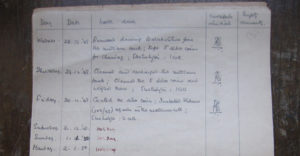
In that week, he held the dancing child-god Krishna in his hands. I imagine his toddler body, squirming and wriggling, resisting a bath. Subramanian also reinstalled the god Vishnu in a cell. In myth, Vishnu, the god who preserves the universe from destruction, rests on a many-headed serpent who floats on the surface of the cosmic waters. I imagine the honor, a boon from Vishnu himself, to allow being plunged into electrolyte. Come, come, I say! Let us sing their names!
“Work Done,” R. Subramanian (1949–50)
Wednesday. Removed dancing Balakrishna
from the medium tank;
kept 5 silver coins for cleaning;
Electrolysis: 1 cell.Thursday. Cleaned and recharged
the medium tank;
cleaned the 5 silver coins
and weighed them;
Electrolysis: 1 cell.Friday. Coated the silver coins;
installed Vishnu (109/45)
again
in the medium cell;
Electrolysis: 2 cells.Saturday. Holiday.
Sunday. Holiday.
Monday. Holiday.
On working days, I was often drawn into the galleries, chasing down a story I’d read in the archives on the surfaces of objects. I needed to verify that these stories might be true and not just some mythic past with no physical trace left behind. But it wasn’t always the bronze galleries that held the promise of truth. One day I climbed the rickety steps to the top of the museum’s “Old Building,” a place where humidity rises and sits in wait for the odd visitor to the natural history collections. I was in search of an acquisition made in September 1940 by museum superintendent Frederick W. Gravely. In that month, he received a box of twenty living spiders of the genus Poecilotheria from Serango, Orissa, courtesy of a Miss Alice Munro, a nurse who knew such spiders to kill both children and livestock with their venomous bite. In sending Gravely these live arachnids, she asked, “May I know . . . [how] you kill them to preserve [them] as specimens?”15 For Gravely, the transformation from a living creature to a specimen required not the removal of a creature’s moisture, but a titration of it. He advised killing spiders with chloroform and then submerging them in ethanol such that it would not be “much diluted by the spiders’ juices.”16 The Poecilotheria metallica on view is not the one Gravely murdered, but another (fig. 6). It is buoyed in a once-clear solution now clouding with age, eight legs splayed out piteously. This fierce hunter, its once-brilliant blue body now rusted to reddish brown, remains plump but lifeless. Is this what we can offer once-living things? A nullification of their vital malignancy in return for a placid, perpetual suspension between life and death? I wondered about that box of twenty spiders, which Munro had warned might not all survive their trip to Madras: “They may . . . fight and kill each other.”17 But what if they had huddled together instead, exchanging their fears in spider-speak, perhaps singing to keep themselves company on their perilous journey? I leaned against the glass and watched patches of moisture appear and disappear with my breath. The air was heavy, even wet, on that August afternoon. “I’ve come to see you,” I said. “I’ve come to sing to you.”
Mobile Chlorides
Four months into my archival research, I was allowed to visit the old conservation laboratory. There’s not much to see, I’d been told. A former temple to the electrolytic reduction of bronzes, it was now a precious ruin, a sealed time capsule. I watched Mr. Jagganathan turn the key in the large padlock. When the door swung open, the air rushed out, electric, crackling with the ghosts of Paramasivan and my grandfather and all the gods and goddesses that had passed the threshold of that building. The electrolytic reduction technique itself has become a practice of the past; since the 1970s, it has ceased being a standard treatment for bronzes laden with bronze disease in museums all over the world.18 The disfavor of this treatment was not about a lack of cure from malignancy; rather, the cure had been too efficacious. Treated bronzes were sometimes deemed too clean, too scrubbed of their desirable patina, and some began changing color over time, darkening as they sat on view. With their mobile chlorides removed, it seemed the bronzes were not quite themselves. Conservators don’t like to speak or write about the inescapable truth that any and all of our treatments will, at some point in the future, be seen as poor decisions. The practitioners of the future will shake their heads at our reports, weighing our flat descriptions of the work we did against the objects themselves, and the objects won’t argue on our behalf, saying in our—my—defense, “She did the best she could. Really, she tried!” All there will be are reports and photographs, but too little of our hopes for what we did, nothing of our own conditions which precipitated our actions.
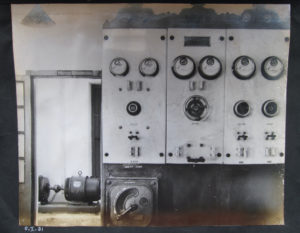
I followed Mr. Jagganathan as he picked a path between stacked furniture and storage boxes to the back rooms, our feet tracking dust. I knew this place from old photographs, but in them, the rooms are pristine and empty, awaiting an erstwhile Goldilocks (fig. 7). He moved a leaning wooden board to show me the now-silenced Metropolitan-Vickers motor-generator, the machine that made electricity flow through the cleaning tanks over decades of treatments, the same device that exploded in Mr. Subramanian’s notes. And standing forlorn on the concrete floors were the electrolytic tanks themselves, massive, more than half the length of my body, their iron skin ruptured with pustules of rust (fig. 8). Bands of powdery green ran the height of the inside of the tanks, a strange stratigraphy of a past in service to cleaning bronzes. I imagined the salts from hundreds of bronzes clinging to these metal cells, congregating, exchanging stories. Still installed in its original location against the wall stood the control panel where the electricity sent into the tanks was precisely modified and monitored. Its marbled surface maintained a dignified exterior despite the fact that all its switches and gauges were no longer functional. To stand next to the control panel is to realize that one looked up to it in use, and to notice that the gauges seem like large googly eyes, their own pupils gazing eternally heavenward. These pieces of equipment—the motor-generator, the tanks, the control panel—had known each other, had worked together for decades. Did it give them comfort to be together in old age? Before turning to leave, I took a photograph of the main operating lever that connected the power from the motor-generator to the control panel. Mr. Harinarayana had told me about it, this all-important switch whose turning on and off marked the beginning and end of each of his working days. In the old photographs, the words cast into its surface are hard to pick out, but in person, they emerge from the surface, defying layers of dust (fig. 9). I ran my fingers along the edges of the words, advice to mobile chlorides, or to us, the practitioners: “Move slowly.”
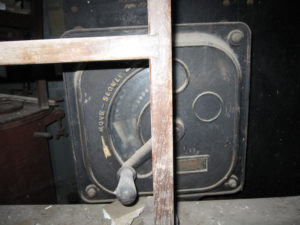
Paramasivan wrote that “malignant patina is due to the presence of copper salts such as the chloride or the sulphate which adheres to the surface and is occluded in the pores of the corroded bronze. They continue the destructive action indefinitely even after the bronze has been removed from the primary source of trouble.”19 More recent studies have suggested that the story is more complicated, that salts are not just external troublemakers that colonize a bronze surface in the form of corrosion, but rather that the corrosion is itself a hybrid entity, the physical product of bronze and salt interacting together. Thus to remove salts from a bronze surface is to acknowledge that we remove something of the bronze from itself. The term “mobile chlorides” recalls this movement, a kind of traveling from place to place but also through places. Why would we expect anything, anyone, even salt, to do so without leaving something of itself behind or acquiring something of the path along its journey? Our current-day treatments for bronze disease are perhaps less self-assured than the electrolytic treatments preferred by our predecessors. Instead of the holistic electrolytic reduction that promised to cure the whole bronze, we now pick only at the symptoms of the disease, using our sharp metal tools to excavate powdery corrosion one patch at a time, worrying the wound clean. Instead of pressing salt into the wound, we dig it out, comforting ourselves that while we scrape away some of the original bronze itself along with the chlorides, it’s less than we might. There is a distinct sound to this treatment, far quieter than any motor-generator, but still jarring: a crunching and grinding of metal against former metal until we hit something solid again. If bronze felt pain, I imagine it would sound like this.
The tenth-century Siva from Melaperamballam dances majestically in his own glass box in the bronze galleries, unflinching, even as he is severely wounded (fig. 10). It takes close looking to notice that a dark shadow on his upraised leg is in fact a large rectangular gash, with several centimeters of bronze missing. The cut edges glint when viewed at just the right angle in the exhibition lights. How easy would it be to nick a fingertip by running it along the profile of that wound? But it is the wound that brought Siva to the museum. In 1937, the museum countered local claimants’ desire to worship the image by arguing that “it is . . . badly broken, one leg being almost severed. . . . It is therefore ceremonially unfit for worship, nor will it be rendered ceremonially fit by mending as this is not permitted by the Sastras [religious texts].”20 Damaged gods could not be worshipped, went the argument, unless on view in a museum. The petition, however, tell us nothing of how Siva came to be damaged, and he is not the only damaged deity who made his way to Madras. Some documents describe other bronzes whose criterion for acquisition depended on their injury, at times caused by the very people who loved them the most. In 1929:
[an] idol of Vishnu was found by one Subbayan Ambalakaran in the ground in front of his house in the village of Vadakadu. While he was chopping wood one evening . . . at this spot, the axe fell from his hand and on striking the ground a metallic sound was heard which aroused the man’s curiosity. He dug a short distance down at the spot and very soon came upon the base of the idol and a short while later with the help of a few others he dug up the complete idol.21
Or in Nagapattinam in 1934:
a number of idols embedded in the earth believed to be [of] Buddhistic origin, were discovered by workmen here yesterday while digging a building site. While digging for building work in a house belonging to one Mr. Varadan Chettiar, the workmen struck something metallic. Further digging revealed the presence of a number of metal idols.22
Wounding was sensory, a physical impact of axe or spade against bronze with an accompanying sound of metal crushing metal. It makes me think of the word “sounding,” a way of measuring the depth of things. Or simply “sound,” as the Junior Dictionary says, “(1) n. Noise. What is heard by our ears. (2) adj. In good condition.” Only the second meaning doesn’t apply.
The “condition report” forms the bulwark of a conservator’s written history. If a treatment report tells, in desiccated prose, the story of what we have done to objects, the condition report tells us what these objects were before our intervention, justifying what we are about to do. To record the physical state of things before we change them is an almost sacred responsibility, and we have developed our own specialized vocabulary for this form of description. My own recent report of an Egyptian bronze reads thus:
The object is stable. The attribute originally held in the proper right hand of the figure is lost. There are old losses to the vertical lapis inlays on either side of the head. The proper left eye inlay is lost. There are traces of gilding on the crown, chin and body. Bright green corrosion is present in the areas of inlay loss on both sides of the head, but the corrosion appears stable.23
To read a condition report is to frequently encounter terms such as “loss,” “stable” (or “unstable”), “damage,” “crack,” “break,” “trace,” “delamination,” “detachment.” Sometimes conservators economize even on writing out these conditions, resorting to using checkboxes to speed documentation. I used to be angry when I read—and wrote—these reports. They seemed cold, unfeeling. Because we see objects at their most vulnerable. We see things that no one was meant to see, the places where the sureness of metal gives way to the yielding softness of corrosion. How dare we simply mark these features as “loss” without sitting with the full impact of that pain? But I’ve begun to wonder if we seem detached from loss in our reports not because we are inured to it, but because it feels safer to package up the loss and damage we see daily in a way that doesn’t destroy us. Because the daily witnessing of the pain of things is emotional work. Because as much as we exult in seeing how the things that come to us for care are those that survived, we also see how much of themselves they’ve lost in the process.
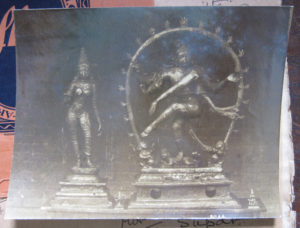
It was months later that I found the original file for the acquisition of the Melaperamballam Siva. In keeping with colonial protocol for the Treasure Trove Act, a photograph was taken of the Siva soon after its discovery in 1935 (fig. 11). The nearly four-foot-tall bronze dances on a wooden table next to a female goddess of equal stature. As Gravely wrote, she is a “Devi image . . . of Sivakamasundari, the consort of Nataraja [Siva], who cannot be worshipped apart from him.”24 Between the power couple sits a diminutive bronze of the elephant-headed god Ganesha, their child: it’s a family portrait, of sorts. On the far right, flanking Siva, is a tiny image of Amman, the fearsome mother goddess and protectress who sits with her right hand upraised in the abhaya mudra, the gesture meaning, “do not be afraid.” Where have they all gone, I wondered. Since finding that photograph, I’ve returned to India on three occasions, each time visiting this Siva, now standing alone in a glass box in the bronze galleries, as I might an elderly relative. For most of my life, each return to India has brought with it an awareness that some of the elders I once knew will be gone the next time I come. There’s little to do but sit with those who are still here, to grasp a shaking hand grown papery and translucent over time and listen to old stories, to hold back or release tears, themselves mobile chlorides, in the communal remembrance of some past time. And so now I visit the Siva, asking after his health, because how lonely it must be to dance the destruction of the universe on one’s own.
But why write these things? Why do I lay bare our vulnerabilities, my vulnerabilities, on a page for you, reader of the future, if you exist? Because reading the stories of the bronzes has made me see their surfaces—to write their surfaces—with the depth of feeling I owe them. Because I don’t want my reports to be all that is left of what I’ve seen and known. I will be honest with you, and myself. I am afraid of being forgotten. I write with the hope that you will know me, know a little of my loss and my love. Because what is a love story without wounds, without loss, without tears?
Please Touch
“Please don’t touch,” conservators tell everyone, as if the privilege of touching belongs only to us, the specialists. Metals, especially, are always to be held in gloved hands, because the mobile chlorides and oils of our hands can transfer, producing fingerprint-shaped corrosion products weeks, months, or years after that initial touch. We say that ominously, but I find it strangely comforting, as if that moment of interaction might still be marked on a surface long after the person who touched it is gone. I’ll admit to removing gloves and touching things with my bare fingertips, tracing the velvet of glassy ceramics, the dense cold of stone, the worn edges of corroded metal. I might have always had this desire, but not always the courage or the authority to act upon it. I’m reminded of myself as a young child watching my grandfather take his afternoon nap, his teeth in a glass by his bedside. I remember looking into his open, cavernous mouth, its pink, pulpy gums gleaming in invitation to be touched. But I never did, the fear of his jaw snapping shut staying my hand.
I forget sometimes that it takes courage to do the work we do as conservators. We witness and record the most vulnerable of stories. We dare to bathe the wounds and prepare the bodies, all with the hope that our interventions might keep these things here with us for perhaps more time than was promised. We care enough to keep up the vigil. This is emotional, difficult, and foolhardy work. After all, our own literature tells us, “Unfortunately most methods of control are impractical.” So why continue our work day after day, generation of conservators after generation, if the cycle of damage might repeat itself? Was our predecessors’—and our own—need to assign malignancy to uncontrollable phenomena a way of making sense of this perpetual responsibility to care for things? Does it helps us to imagine that there is an explanation or even a motivation for why the objects we’ve grown to love change or deteriorate? Perhaps imagining ourselves on the side of good makes it easier to face up to the inevitability of loss. But to think this way means we assume that the objects themselves have no role in what happens to them, that they lie lifeless, waiting to be changed. And I know this isn’t true. What if “malignant patina” is the way that bronzes communicate with us, invoke our care, invite our touch again? What if they are lonely, and want to be with someone who will ask after them, as a loved one might?
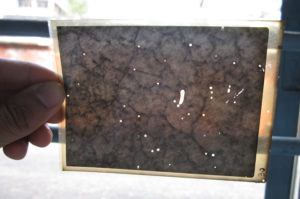
After finding the 1942–43 “Administration Report” that tells me about my grandfather’s part in this story, I go back to the conservation laboratory to seek out a set of negatives that I’d previously set aside with disinterest because I couldn’t understand them. I hold up the film (fig. 12) to the light of the window, the insect holes more legible to me than what the image itself depicts. The label says, “No. 2. Head of the axe,” but the picture shows a much more intimate history to those who can read it. To my grandfather, the metallurgist who might have made this picture, or to Paramasivan, who might have requested that this picture be made, the metallographic cross-section captures the history of how the axe was forged and worked by an ancient metalsmith. To me, all that is intelligible are the traces of corrosion between grains of metal, a patina of sorts, deep within the axe-head. The remainder of the story rests for now only with my grandfather and Paramasivan. Dust dances in a late afternoon sunbeam. “You haven’t forgotten us,” Paramasivan and my grandfather say. I hold the negative higher, catching more light. “No,” I say. “How are you?”
*
Sanchita Balachandran is the associate director and conservator at the Johns Hopkins Archaeological Museum and senior lecturer in the Department of Near Eastern Studies at Johns Hopkins University.
The original research for this article was supported by a 2009–10 Fulbright Award from the United States-India Educational Foundation. At the Government Museum, I remain grateful to current commissioner M. S. Shanmugam, former commissioner Dr. T. S. Sridhar, and the museum’s staff, especially Mr. Balasubramanian, Ms. Gandhimathi, Mr. N. Harinarayana, Mr. Jagganathan, Dr. V. Jeyaraj, and Mr. Mani. At the Tamil Nadu State Archives, Research Hall, I thank Ms. Gomathi, Mr. Yuvraj, Mr. Chandran, Mr. Neelavarnan, Mr. Suresh, and Mr. Chandran for their assistance. My heartfelt thanks to Peter N. Miller and Paul Stirton at Bard Graduate Center for inviting this paper, and Florence Grant for her deft editing. Many generous relatives, friends, and colleagues made it possible to cross-check various threads of this story: Emily Anderson, Lisa Barro, Betsy Bryan, Elliott Hunstman, Michael Meister, K. B. Nair, Mrs. K. P. B. Nair, Ravindran Nair, M. Ganesa Pandian, David Saunders, and Prajod Varma. Anand Pandian gave gentle advice on several earlier drafts of this paper. I owe the greatest debt to my grandfather, metallurgist K. P. S. Nair, for beginning this work nearly a century ago.
- 1. Junior School Dictionary: Illustrated in Color, compiled by Isabel Mary McLean, text copyright Frederick Warne, London, book copyright FEP International Private Limited (New Delhi and Allahbad: Roli Books International, 1979).
- 2. Sanchita Balachandran, “Transformative Spaces: Dr. S. Paramasivan and Conservation Science in India in the Early Twentieth Century,” Studies in Conservation 64, no. 1 (2019): 24–41.
- 3. S. Paramasivan, “The Chemical Laboratory in the Madras Government Museum,” in Centenary Souvenir 1851–1951: The Madras Government Museum (Madras: Government Press, 1951), 104.
- 4. C. G. Fink and C. T. Eldridge, The Restoration of Ancient Bronzes and Other Alloys (New York: Metropolitan Museum of Art, 1925), 5.
- 5. G. W. Martin, “Paradichlorobenzene in the Herbarium,” Botanical Gazette 79, no. 4 (1925): 450.
- 6. H. W. Nichols, B. Laufer, and O. C. Farrington, Restoration of Ancient Bronzes and Cure of Malignant Patina (Chicago: Field Museum Press, 1930), 47.
- 7. “Administration Report of the Government Museum and Connemara Public Library, Madras, for the Year 1942–43,” unpublished, 3, Government Museum Archives.
- 8. Government Order No. 1625, July 21, 1937 (Education Department), Tamil Nadu State Archives.
- 9. S. Paramasivan, “Electrolytic Restoration of Bronze Statues and Inscribed Copper-Plates,” Proceedings of the Indian Academy of Sciences, Section A 13, no. 1 (1941): 56.
- 10. D. A. Scott, Copper and Bronze in Art: Corrosion, Colorants, Conservation (Los Angeles: Getty Publications, 2002), 126; M. Gilberg, “Friedrich Rathgen: The Father of Modern Archaeological Conservation,” Journal of the American Institute for Conservation 26, no. 2 (1987): 105–20.
- 11. See Paramasivan, “Electrolytic Restoration,” and Balachandran, “Transformative Spaces,” for more information on this technique.
- 12. Paramasivan, “Electrolytic Restoration,” 59.
- 13. Unpublished “Conservation Register,” 1949–51, Chemical Conservation Laboratory, Government Museum, Chennai.
- 14. Treasure Trove File for Kannarikottai, 1927, Government Museum Archives. I am grateful to M. Ganesa Pandian for this translation.
- 15. Alice Munro to Frederick W. Gravely, September 20, 1940, Government Museum Archives.
- 16. Gravely to Munro, [late September–early October, 1940], Government Museum Archives.
- 17. Munro to Gravely.
- 18. Scott, Copper and Bronze, 363.
- 19. Paramasivan, “Electrolytic Restoration,” 56.
- 20. Frederick W. Gravely to the Secretary to Government, Law (General) Department, March 11, 1936, Government Museum Archives.
- 21. Order from the Collector of Tanjore, February 22, 1929, Government Museum Archives.
- 22. Clipping from the Madras Mail, January 6, 1934, Government Museum Archives.
- 23. Sanchita Balachandran, condition report for object ECM 1714, 2010, Johns Hopkins Archaeological Museum.
- 24. Gravely to the Secretary to Government.
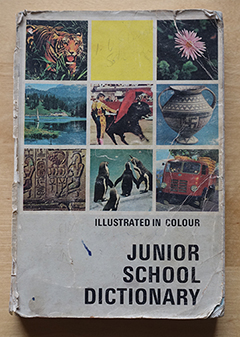
Fig. 1. Dictionary printed by Roli Books in New Delhi, 1979. Image by author.
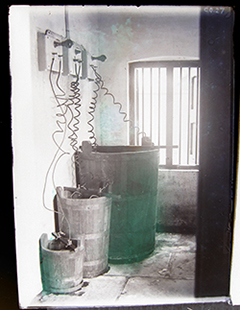
Fig. 4. View of the wooden barrels first used as electrolytic reduction tanks, n.d. Image courtesy of the Government Museum, Chennai.
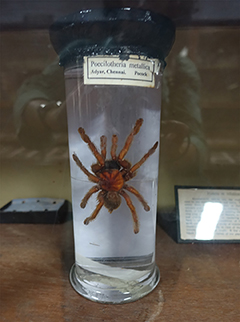
Fig. 6. Poecilotheria metallica on view at the Government Museum, 2017. Image by author. Published with permission from the Government Museum, Chennai.
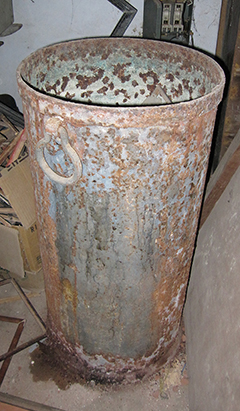
Fig. 8. One of the metal tanks previously used in electrolytic reduction, 2009. Image by author. Published with permission from the Government Museum, Chennai.
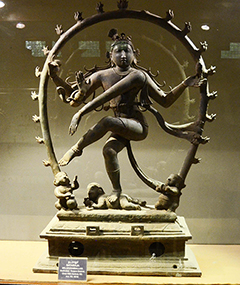
Fig. 10. The Siva from Melaperamballam in the Government Museum bronze gallery, 2017. Image by author. Published with permission from the Government Museum, Chennai.
